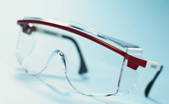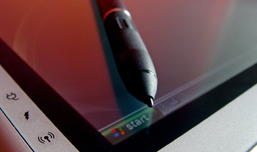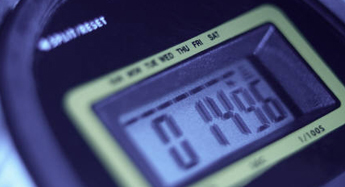Wearable technology enters business mainstream
The inexorable rise of mobile computing and connectivity over the past decade has delivered us increasingly powerful smart devices, and for many, portable laptops, smartphones and tablets have now become indispensable.
Recently, the move towards 'ubiquitous computing' has led to the development of a new technology category: wearable technology; i.e. devices worn on or even inside the body. Most of these devices are ‘smart’, too, combining computing power and connectivity with cloud computing for data storage and handling, and often operate in partnership with a smartphone, which acts as the internet hub for the device.
 Google Glass is arguably the most well-known example of wearable technology to date. This prototype ‘smartglass’ device can take videos or photos and project information from the internet into the right eye of the wearer via a tiny display. As well as smartglasses, the rapidly increasing number of wearable devices on the market or in development includes fitness and health monitoring devices – such as Fitbug and Nike Fuelband – wearable cameras, smartwatches and smartclothing. And along with these consumer devices, there are industrial, medical and military wearables.
Google Glass is arguably the most well-known example of wearable technology to date. This prototype ‘smartglass’ device can take videos or photos and project information from the internet into the right eye of the wearer via a tiny display. As well as smartglasses, the rapidly increasing number of wearable devices on the market or in development includes fitness and health monitoring devices – such as Fitbug and Nike Fuelband – wearable cameras, smartwatches and smartclothing. And along with these consumer devices, there are industrial, medical and military wearables.
Wearable technology goes public
In 2013, wearable technology entered the consumer mainstream. The limited release of Google Glass and the launches of the wearable camera, Autographer, and Samsung’s Galaxy Gear smartwatch were among many developments over the past 12 months that generated a huge amount of buzz around this emerging technology category.
With more product launches expected in 2014, such as the general release of Google Glass, this growth trend promises to continue, even accelerate. Market analysts agree, with Gartner predicting that the industry will be worth $10 billion by 2016, and Credit Suisse suggesting it will grow from $1.4 billion this year to a substantial $50 billion by 2018.
As such, it seems inevitable that in 2014 many more businesses will follow the early adopters and start exploring the potential innovative commercial applications of this technology.
Early adoption by businesses
Wearable devices that improve productivity by boosting morale, promoting wellness and/or enhancing self-awareness are likely to become of interest to enterprises in a wide range of industries. These devices tap into the ‘quantified self’ movement, which involves using data from self-tracking devices to improve areas of a person’s life, and gained huge momentum in the consumer arena in 2013. Some early adopters have already picked up on this movement in the business context:
 Cloud broker Appirio offers Jawbone UP devices to employees as part of a wellness programme. The device enables employees to ‘life-log’ their daily activity, body metrics and sleep patterns, and share their progress with others, with a view to promoting fitness and wellbeing within the organisation.
Cloud broker Appirio offers Jawbone UP devices to employees as part of a wellness programme. The device enables employees to ‘life-log’ their daily activity, body metrics and sleep patterns, and share their progress with others, with a view to promoting fitness and wellbeing within the organisation. - Health insurer, Pru Health, offers a Fitbug health and fitness wearable device as part of its 'Vitality' programme. Members are given incentives in exchange for doing a certain amount of exercise and sharing, via Fitbug, data on their day-to-day exertions.
Other industries have also begun to explore the potential benefits of wearable devices, including the following:
- In the retail industry, smartglasses have been used with the aim of improving the efficiency and accuracy of supply chain and warehouse operations. For example, at a Tesco distribution centre in Ireland, workers have been given smart armbands to wear that track the goods gathered, allocate tasks and measure the workers' movements within the building.
- Sony has recently filed a patent for 'SmartWig', an internet-connected wearable device that the technology company suggests could measure a user's blood pressure, track their location, navigate roads and could even be used as a virtual reality device in the gaming industry1.
- Air transport industry IT provider, SITA, has carried out tests using Google Glass and Vuzix M100 smartglasses to evaluate the devices' utility in a variety of settings. For example, the company is looking at how these wearables can help airport staff to work hands-free and remain mobile while interacting remotely with check-in and reservation IT systems using voice recognition and other means2.
- In the construction industry, sensors for assessing job site safety are in development at the Virginia Tech College of Engineering in the US. The first of these is a pulse oximetry that is fitted to a construction helmet and continuously monitors the carbon monoxide levels in workers’ blood.
BYOD: wearable devices in the workplace
 In addition to an increased use of wearable technology by businesses, it’s highly likely that 2014 will see an increasing number of employees wishing to use their personal wearable technology in the workplace. This would mark the start of a new wave of the BYOD trend, which began with smartphones and tablets, and to which employers will have to respond3. The potential for wearable devices such as smartglasses and wearable cameras to capture business data and images and audio of employees will bring a new set of challenges for employees to consider, including those relating to the protection of confidential information, privacy and their role in employee grievance procedures.4
In addition to an increased use of wearable technology by businesses, it’s highly likely that 2014 will see an increasing number of employees wishing to use their personal wearable technology in the workplace. This would mark the start of a new wave of the BYOD trend, which began with smartphones and tablets, and to which employers will have to respond3. The potential for wearable devices such as smartglasses and wearable cameras to capture business data and images and audio of employees will bring a new set of challenges for employees to consider, including those relating to the protection of confidential information, privacy and their role in employee grievance procedures.4
Privacy and other legal issues
The multitude of uses of wearable devices are still being explored by early adopter consumers and businesses alike, and the mainstream may wait to jump on the bandwagon once the benefits become more widely apparent. But regardless of the point at which businesses begin to adopt the technology, they will need to consider the data protection and other legal issues arising from its particular use.
By their very design, many of these wearable devices can capture a great deal of personal data about the wearer, and the business or businesses processing that data will need to ensure that they are doing so in a lawful way. For example, certain health and fitness gadgets can have GPS location functionality and can capture a huge amount of data over time about a person's location, activity and even health. Technology providers handling data collected via wearable devices will need to ensure that they are transparent about how the data is being used, obtain informed consent from the wearer and put in place adequate security measures to protect the data.
Other wearable devices – such as smartglasses and wearable cameras - capture images and footage of individuals in the vicinity of the wearer, and present a number of privacy challenges for businesses allowing the devices in the workplace or using them for a commercial purpose. The potential of these devices to record images surreptitiously has led to fears about the erosion of our privacy, and the arguments voiced in 2013 about this are likely to resurface in 2014 in the wake of the general release of Google Glass.
Wearables in business in 2014
 As wearable technology entered the consumer mainstream this year, so it is likely to begin to enter the business mainstream in 2014. Early adopters in business will pave the way for their industry counterparts, who may begin to experiment with and exploit new ways of using the technology for commercial benefit. In order to exploit the technology in a lawful way, businesses will need to address the applicable data protection and other legal challenges that arise. Similarly, tech-savvy employees will no doubt bring their new toys to play with at, and for, work, raising a host of other issues which employers will need to consider.
As wearable technology entered the consumer mainstream this year, so it is likely to begin to enter the business mainstream in 2014. Early adopters in business will pave the way for their industry counterparts, who may begin to experiment with and exploit new ways of using the technology for commercial benefit. In order to exploit the technology in a lawful way, businesses will need to address the applicable data protection and other legal challenges that arise. Similarly, tech-savvy employees will no doubt bring their new toys to play with at, and for, work, raising a host of other issues which employers will need to consider.
If you have any questions on this article please contact us.
1See Sony File Patent for 'SmartWig'
2See Air Transport Industry Moves Towards Google Glass and Smart Watches
3For a summary of some of the BYOD issues to consider, see BYOD: solving data protection compliance issues
4 The Wearable Technology Revolution: is your workplace prepared?


Louise Taylor
Louise Taylor looks at the move towards wearable technology and some of the legal issues that accompany this relatively new technology, as it goes mainstream.
"As wearable technology entered the consumer mainstream this year, so it is likely to begin to enter the business mainstream in 2014."

